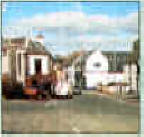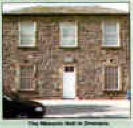
'Sleepy' village is steeped in character
DOWN YOUR WAY
This week Jakki Black looks at the history of Dromara
23/03/2001
DROMARA is known to the locals as 'the sleepy village', and you can see why with a relaxed and easy atmosphere that is steeped in character.
 It is however a village of stark contrast, green fields looking onto towering
mountains. Old houses that have reared generations of families surrounded by modern bungalows and shops along with atmospheric pubs.
It is however a village of stark contrast, green fields looking onto towering
mountains. Old houses that have reared generations of families surrounded by modern bungalows and shops along with atmospheric pubs.
Dromara is ringed by the thriving towns of Lisburn, Dromore, Banbridge, Rathfriland and Ballynahinch, with Castlewellan and Newcastle a few miles beyond.
Dromara, the village of the rath, has been known at other tithes as 'Drumbara', and 'Annesborough', but in the 19th century it was settled as Dromara.
Ownership of much of the land has been traced back to the McGuinness family and it was transferred to the Hill family in the 17th century and subsequently the Marquis of Downshire.
It is said that one of the oldest men in the world, Mr. William Smith, lived in a cottage in Dromara, Bells Bridge.
 He was born in 1801 and was known locally as 'nosey', due to the shape of his nose which was the
result of a bullet wound he may have received at the Battle of Dolly's Brae. He was said to have lived to the age of 124.
He was born in 1801 and was known locally as 'nosey', due to the shape of his nose which was the
result of a bullet wound he may have received at the Battle of Dolly's Brae. He was said to have lived to the age of 124.
In the hillier parts of Dromara there are many examples of 'famine fields' or 'lazy beds'. These are patches of ground which have been tilled by hand. When the famine came the ground was just left with the drills intact. The result is that on a good sunny day you can still see the shadow of the drills and there are still the remains of many homes dating back to the famine.
More recently Hollywood legend Errol Flynn loved Dromara and often went hunting there with the locals. O'Reillys pub in the centre of the village has a wonderful photograph of the man himself to prove that the charms of Dromara attracted even the most cosmopolitan with its simple beauty.
 Probably the most famous person to come from Dromara was the engineering genius Harry Ferguson who was born in 1884 in the townland of
Growell, three miles from the village.
Probably the most famous person to come from Dromara was the engineering genius Harry Ferguson who was born in 1884 in the townland of
Growell, three miles from the village.
Harry invented a four wheel drive system as well as his own plane, which he flew on New Year's Eve 1909. He went 150 yards in Newcastle and became the first man to fly in Ireland, and the first Briton to build and fly his own plane.
After being to America a few times Harry approached the famous Henry Ford who had done for the motor industry what Harry was to do for agriculture. A partnership was entered between the two men and the Ford Ferguson tractor was produced.
Henry Ford was one of Harry's greatest admirers describing him as a genius on the same level as Edison, Bell and the Wright brothers, but in the latter part of the friendship they had a dramatic fallout and the Northern Ireland man sued the Ford Motor Company of America for a staggering $251 million.
 Along the way to fame and fortune Harry married Dromore grocer's daughter Maureen Watson, who was devoted to him.
Along the way to fame and fortune Harry married Dromore grocer's daughter Maureen Watson, who was devoted to him.
The early development of Dromara was based around a bleach ground for flax, two scotch mills and a corn mill.
The flax industry has a long association with Dromara with the bleach green at Woodford dating back to before 1810 and there are linen trade connections to this site going back to 1758.
In the 19th century Dromara became the site of the highest bleach greens and scotch mill on the Lagan. The labour force was drawn chiefly from the surrounding area but some specialised labour came from as far away as Belgium.
When the war ended in 1945 demand for flax declined. Much cheaper man-made
fibres were coming on the market with the result that many
mills closed.
Many local people still have memories of those days when the flax industry was a big part of their lives and remember the Belgians who came and lived and worked with them.
The village is full of characters with colourful nicknames such as the Sheriff, the Cowboy, the Rabbit, Jackie Dee and Big Daddy.
Big Daddy is a local farmer in the area. He has been farming since he left school he told me that he remembered the first tractor being brought onto the farm in 1954.
"Up till then we always used horses to plough the land, the work was a lot harder and slower but we were never short of a bit of 'craic"' he said.
"Dromara is a great wee village and I would have to say that one of the main attractions is the good cross community relations we have here.
"As a village we have always respected each other and been concerned for the well being of those around us, promoting a great community relation ship and value of other's opinions and beliefs, something I hope we never lose."
Tom McFee, a grocer in the village, said: " There is a lot of development in Dromara now but I remember where the playground is now used to be all water, a dam of some sort.
"As youngsters when it was frosty we used to skate on the ice, which really we shouldn't have been doing, but we didn't realise the danger."
Dromara has also seen changes with the creation of extended riverbank walks.
There has also been an enhancement of the village square creating an attractive centerpiece along with a paved area and shrubs.
Dromara also now has a new community centre, which has taken a long time to get up and running, and much of the work in getting this going has been by Joyce Poots and her husband Stanley who are very active members in the Community Association, with Joyce being involved in teaching arts and crafts to the over 50's for three years now, as well as being involved in other projects within the community.
Dromara represents old and new along with all that is good with a rural village. You can be entertained, fed and watered.
